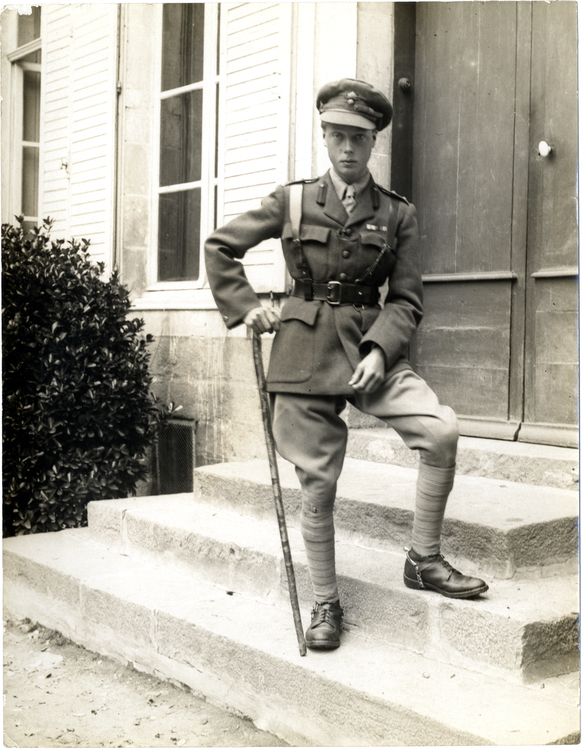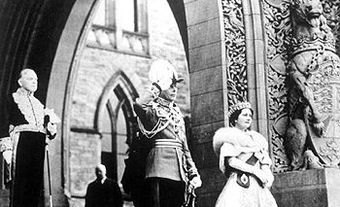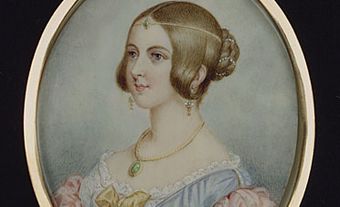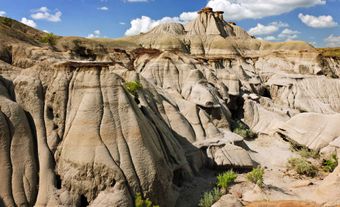Edward Albert Christian George Andrew Patrick David, HRH Prince of Wales from 1910 to 1936, HM King Edward VIII from 20 January to 11 December 1936, HRH The Duke of Windsor from 1936 to 1972 (born 23 June 1894 in White Lodge Richmond, Surrey, England; died 28 May 1972 in Paris, France). Edward toured Canada on several occasions and purchased a ranch in Alberta. He is best known for abdicating the crown and marrying American divorcee Wallis Simpson. Edward is mentioned in novels by several Canadian authors, including Robertson Davies, Lucy Maud Montgomery and Timothy Findley.

HRH Edward Prince of Wales, on board ship (autumn 1923).
(courtesy Dept. of Mines and Technical Surveys, Library and Archives Canada / PA-023122)
Early Life and Education
Edward was born in the reign of his great-grandmother, Queen Victoria. He was the eldest of six children of the Duke and Duchess of York (the future King George V and Queen Mary).
Edward was educated at home until the age of 13. He then attended Royal Naval College, Osborne, from 1907 to 1909, and Royal Naval College, Dartmouth, from 1909 to 1911. Following the accession of his father as King George V in 1910, Edward became Prince of Wales. He studied History and Modern Languages at Magdalen College, Oxford University, from 1912 to 1914 but did not complete a degree.
The First World War
Edward joined the Grenadier Guards in June 1914. He volunteered for active service on the outbreak of the First World War in August but was instead made staff officer to Sir John French, Commander-in-Chief of the British Expeditionary Force. Edward chaired the Patriotic Fund for the care of soldiers and sailors and visited troops from the British Empire and Dominions, including Canada. Edward was with the Canadian Corps when the armistice was signed in 1918 and wrote to a friend of his admiration for the Canadian troops, “living amongst them makes me just long to go there.”

The Prince of Wales at the Front [Merville, France], 8 August 1915.
(photo by H.D. Girdwood, courtesy British Library/Wikimedia CC)
Personal Life
In the 1920s and 1930s, Edward was expected to marry either a European princess or a British aristocrat. Instead, he became involved with a series of married women, including Freda Dudley Ward, Thelma Furness and, from 1934, Wallis Simpson, a twice-divorced American. His parents disapproved of these relationships and sent him on extended overseas royal tours.
Canadian Tours
In 1919, Edward toured Canada for two months to thank Canadians for their contributions to the allied victory in the First World War. These tours were very popular with the public. Edward returned for a seven-week tour in 1923. He also made an unofficial visit in 1924. In 1927, he toured Canada with his brother Prince George (later Duke of Kent) in honour of the 50th anniversary of Confederation, opening the Princes’ Gates and Prince Edward viaduct in Toronto.
Edward was the first member of the royal family to describe himself as a Canadian on an official tour. In a 1919 Calgary speech he declared, “I came to Canada as a Canadian in mind and spirit, I am now rapidly becoming a Westerner.” In a letter to his mother, Queen Mary, Edward wrote, “We belong to Canada and the other Dominions just as much as we do the UK.” On future tours, members of the royal family would continue to emphasize their close relationship with Canada.
Edward was also friends with several prominent Canadians living in the United Kingdom, including Sir Edward Peacock, director of the Bank of England, and Max Aitken, Lord Beaverbrook, a politician and publisher of the Daily Express newspaper.
The EP Ranch
During the 1919 Canadian tour, Edward purchased a 41-acre ranch near Pekisko Creek in rural Alberta. Edward visited the ranch on his Canadian tours and commissioned a new ranch house in 1927. He also imported Shorthorn cattle, Dartmoor ponies, Shropshire sheep, and Clydesdale horses from the United Kingdom. Edward visited the ranch privately in the 1940s and 1950s and did not sell the property until 1962.
Accession to the Throne
King George V died on 20 January 1936. On 21 January, Edward was formally proclaimed king. However, Edward neglected his official duties and was determined to marry Wallis Simpson, who was not considered an acceptable queen consort at that time because she was a divorcee. This undermined British political support for his reign. Canadian popular opinion was divided. Canadian Prime Minister William Lyon Mackenzie King spoke to Edward about his responsibilities, reminding him how much he was admired in Canada and that the prestige of the Crown must not be damaged.
Vimy Memorial
On 26 July 1936, Edward VIII unveiled the Canadian National Vimy Memorial in France. The ceremony was attended by more than 100,000 people. The king met with dignitaries and mingled with the crowds, stopping to speak with veterans and with widows and mothers of servicemen who had died during the war. He then made a brief speech before unveiling the memorial.
Around us here today there is peace and the rebuilding of hope … in dedicating this memorial to our fallen comrades our thoughts turn rather to the splendour of their sacrifice, and the consecration of our love for them, than to the cannonade which beat upon its ridge a score of years ago. In this spirit, in the spirit of thankfulness for their example of reverence, for their devotion, and of pride in their comradeship I unveil this memorial to Canada's dead.
The Abdication Crisis
On 11 December 1936, Edward announced his abdication as king in a radio broadcast. He was succeeded by his younger brother, George VI, the father of Queen Elizabeth II. After abdication, Edward was made Duke of Windsor.
The Canadian cabinet not only consented to the British abdication legislation, His Majesty’s Declaration of Abdication Act, 1936, but also passed Canadian legislation, The Succession to the Throne Act, 1937, ratifying this decision. This was significant. By passing independent legislation, Canada was asserting its independence and autonomy regarding the Crown in Canada. (See also 1931 Statute of Westminster and 1939 Royal Tour.)
Duke of Windsor
On 3 June 1937, Edward married Wallis Simpson in France. The couple made a controversial visit to Nazi Germany in October that same year. Edward was appointed governor of the Bahamas in 1940 to remove him from Europe during the Second World War.
In the Bahamas, Edward befriended Canadian gold mining millionaire Harry Oakes. Oakes was murdered in mysterious circumstances in 1943, and Edward was criticized for interfering with the investigation. Edward returned to France in 1946 and lived there until his death in 1972.
Edward In Canadian Culture
Edward is mentioned in many works of Canadian literature. In Robertson Davies’s novel Fifth Business, for example, a character models himself on Edward, “the great ambassador of the Commonwealth, [who] had also the common touch.” In Lucy Maud Montgomery’s novel, Mistress Pat, a farm worker claims that he once worked on the Alberta ranch belonging to Edward, “a very democratic young man.” After the abdication crisis, literary portrayals of Edward became much more critical. Timothy Findley depicted the Duke and Duchess of Windsor as ambitious, selfish and complicit in a Nazi plot to restore Edward to the throne in his final novel, Famous Last Words.

 Share on Facebook
Share on Facebook Share on X
Share on X Share by Email
Share by Email Share on Google Classroom
Share on Google Classroom




